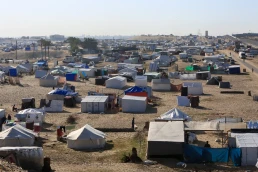Yemen’s rich and complex history was upended by its catastrophic civil war beginning in 2014. A peace agreement could help Yemenis recover the frustrated hopes of the 2011 uprising — if Saudi Arabia stops demanding victory for its allies.
An Interview with Helen Lackner, Jacobin
Over the past few years, Yemen has featured in the news as one of the world’s worst humanitarian crises. The hopes of the protest movement in 2011 gave way to civil war and a brutal Saudi-led invasion.
But the people of Yemen aren’t just the victims of a political tragedy. In its modern history, Yemen has inflicted a humiliating defeat on the British Empire. One part of the country became the only Arab state to adopt Soviet-style Marxism as its ideology. Yemen’s path to its current disastrous condition is a complex and fascinating story that tells us a lot about the modern world system.
Helen Lackner is one of the leading experts on modern Yemen. She spent several years living in the country and has written numerous books and articles about it, including Yemen in Crisis: The Road to War.
This is an edited transcript from Jacobin’s Long Reads podcast. You can listen to the episode here.

HL: Yemen within its current official borders had never existed as a single state in the past, and I think that’s worth remembering when trying to analyze the current situation. Way back, you had a number of different states that covered different parts of the country. More recently, in the nineteenth century, you had Ottoman rule in what were roughly the borders of what became the Yemen Arab Republic (YAR), or North Yemen. After the British arrived in 1839, they gradually took control, to a large extent and not necessarily that closely, of what later became the People’s Democratic Republic of Yemen (PDRY), or South Yemen.
Recent Posts
Stop Israel’s Dystopian “Humanitarian City” Plan—Before It’s Too Late
July 11, 2025
Take Action Now For the past 20 months, the world has watched—and largely enabled—a genocidal campaign in Gaza. Over 55,000 Palestinians have been…
The “Liberal” International Order Is Criminalizing Palestine Protests
July 11, 2025
Take Action Now As Western governments repress Palestine solidarity and enable Israel’s impunity, the “liberal international order” is no longer…
Politicians Are Betraying Gen Z On Climate
July 10, 2025
Take Action Now While Gen-Zers thrift, knit, crochet, and find other ways to reduce our footprints, Trump and the GOP are greenlighting more climate…
Trump’s Deportation Threat Against Zohran Mamdani Is Shameful
July 10, 2025
Take Action Now In only half a year of Donald Trump’s presidency, he and his allies have turned deportation into an explicitly political threat…




